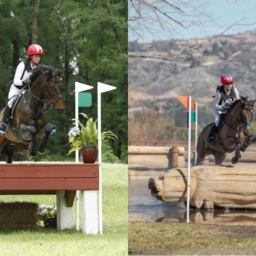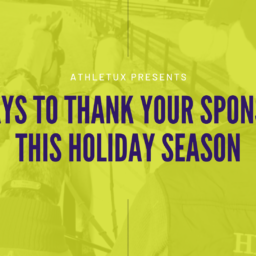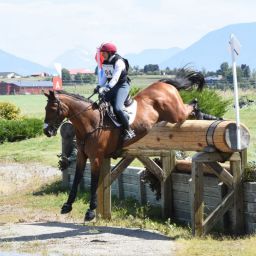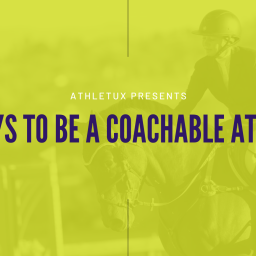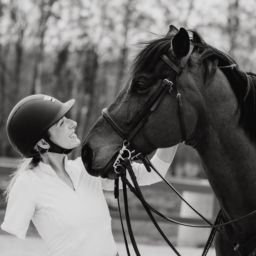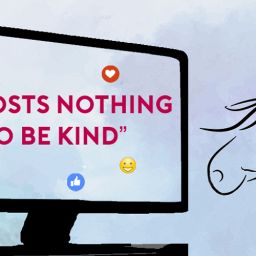
Lismakeera Brewski’s Story
By: Gaby Ruane
Photo by Eventing Nation
Carlo’s story: After a string of horse injuries and just general bad luck, I was looking for a horse to take me up through to the FEI levels of eventing. Enter Carlo, a 6 coming 7-year-old ISH gelding. He came to Holling Eventing as a sales horse and I was given the opportunity to ride him until he sold. Neither of us had competed above the Preliminary level, but he was game and we hit it off immediately. It didn’t take long for me to decide that he needed to stay, and I purchased him in October of 2016. After a few successful outings at Training and Preliminary, we completed our first CCI2*-L in Ocala in April of 2017. After the event, Carlo was given nearly a month off, and my plan was to tack walk him for two weeks, before legging him up for the fall season. We had our first ride back on May 8th, and all was normal. The next morning, I arrived to work at 6:30 AM to feed. While dumping Carlo’s grain, I noted that he looked a little stiff, but he had been in during the night and I didn’t think much of it. I returned from riding a few other horses around 10 AM, and pulled Carlo out of his stall to get him tacked. I could immediately tell that something was not right. His walk was abnormal, his steps were large and very high. It was clearly laboring for him. I walked him down the aisle and out of the barn, hoping that he might work out of it. When it became clear that he was getting worse by the minute, we performed a basic neuro exam, which he failed spectacularly. Just standing was becoming difficult, and pivoting him around was nearly impossible without someone helping to stabilize him. His temperature was 104 degrees. Our vet, Dr. Lisa Casinella, was called and when she didn’t answer I texted “EMERGENCY!” and sent her several videos of Carlo attempting to walk. While we waited, we administered Banamine to try and keep his temperature under control, and he was given dozens of ice baths over the course of the next several hours.
Dr. Casinella arrived around 4 pm and was troubled by what she saw. By this point, Carlo was extremely ataxic and relying on the wall for support. Lowering his head (just from wither level) to the floor to try and attempt to eat took nearly 45 seconds. Fearing it might be the beginning of a Herpes outbreak, we quarantined the barn and Dr. Casinella made the call to book Carlo into the University of Florida Large Animal Hospital that night. Somehow, we managed to get him onto a trailer, and we were off.
Once we arrived, he was quickly settled into an isolation stall. It was noted that he presented with a fever, ataxia (grade 3 in both hinds, and grade 2 in both fronts), and hypermetria. He remained in isolation for about 48 hours, while we waited to rule out both Equine Herpes Virus and West Nile Virus. Fortunately, both tests yielded negative results, and he was transferred to the main hospital.
Carlo remained at UF for a total of 7 days. I was able to visit him and witness firsthand the excellent care he was receiving under internal medicine specialist Dr. Chris Sanchez, and resident Dr. Elizabeth Neslon. He was tested for Lyme, as well as EPM, and underwent a spinal tap. The results of the tap revealed some inflammation. Cervical radiographs were also taken but showed nothing of interest. Over the course of the week, he was almost completely back to normal, from a neurologic standpoint. He received only Banamine during his stay and was discharged while we waited for the EPM and Lyme test results. When those came back negative, they sent in his CSF to determine whether we could rule out lymphoma as well. He was sent home with instructions to administer Banamine once every 24 hours for a few more days and to closely monitor him for signs of fever and ataxia.
Shortly after Carlo arrived home, we decided to start treating him for Lyme. Test results for this disease can often be unreliable, and a false-negative wouldn’t have been out of the realm of possibility. We had nothing else to go on, so it was worth a shot. He started receiving potassium Penicillin via a catheter but we continued battling high temperatures (hovering around 105 degrees). While we were initially hopeful that he might improve with this course of treatment, after several days it was apparent that he was growing steadily worse. While he remained mostly normal neurologically, his temperature skyrocketed to 107 degrees and we struggled to get it down again. On May 19th, just four days after he had been discharged, he was loaded up and we drove back to UF with his temperature hovering just above 105 degrees.
To make things more stressful, 10 minutes into the trip we were involved in a multi-vehicle collision. The back of the trailer and rear lights were damaged, but only minimally. Fortunately, Carlo was in the front stall and was completely unscathed. Worse than the collision itself was the time we had to spend sitting on the side of the highway waiting for the Florida Highway Patrol, the fire department, and an ambulance with a very sick horse stuck in a very hot trailer. Carlo was so wonderful and calm through the entire ordeal, but I was a little shaken, so I called Jon’s then-groom Katy [Long], and asked her to meet me at the scene. Once the officer arrived and we made our statements, I begged him to let us leave, and to allow us to drive with the broken lights so we could get to UF as quickly as possible. Luckily he agreed, and we hit the road again.
Upon arrival, with his temperature at 103.5, he was quickly settled into an air-conditioned stall. We then took him for an abdominal and thoracic ultrasound, and then thoracic radiographs, but the results were unremarkable. Carlo stayed in the hospital for 11 more days. He began to show improvement once again, and although his temperature would spike to 102 or 103 in the afternoons, it remained at a much more acceptable level for most of the day. He continued his penicillin treatment while there and began receiving oxytetracycline in addition to doses of dexamethasone and Banamine. He was discharged on May 29th, with instructions to start on Minocycline once he was through with the oxytetracycline. Frustratingly, the “case” for his persistent fever was still wide open. They had ruled out Equine Herpes Virus, West Nile Virus, EPM, Neuroborreliosis, and 2/3 tests for lymphoma. He had one remaining test for lymphoma as well as a blood test for Anaplasmosis, both pending at the time of discharge.
At this point, we were stumped. Carlo had an incredible team of some of the best vets in the country looking into his case and nobody had any answers. His future, if any, seemed bleak. He didn’t look anything like the horse I had first met. He was the same sweet boy that he had always been, but he wasn’t himself anymore. Physically, he had severe muscle atrophy and was very thin. His feet and coat were dull and brittle, and he was extremely weak. This illness seemed to be sucking every last bit of life out of him, but still, he fought on.
During the month of June, Carlo continued his treatments at home and was able to spend a little time out in his field. His attitude seemed to be improving, but he was not out of the woods with his fevers. Overall, the numbers had started to come down, but they were still hovering around 103 degrees. He also started developing new symptoms, the most alarming being swelling of the head. This swelling occurred mostly on his forehead, traveling down to just below eye level, and he developed a large bump on the front of his nose. It was very noticeable and extremely concerning. In addition to his head, he had swelling in his sheath and abdomen. Then he started having problems in both eyes, and Dr. Casinella diagnosed that as uveitis. Lastly, he began losing hair and pieces of skin in small patches, also on his abdomen.
On June 29th, I took him back to UF, as his fever still remained largely unresponsive to treatment. Upon arrival, and closer examination of the facial swelling, it was determined that it was associated with bone and was quite painful to palpate. The cause of which was never determined. In addition to an eye exam, in which uveitis in both eyes was confirmed, skin biopsies were also taken. Another spinal tap was performed, which revealed there was still evidence of inflammation. A second Lyme multiplex was submitted as well. I picked him up later the next day, June 30th.
Once home, it was again touch and go. Test results came back, and all were negative and/ or inconclusive. It appeared that we could officially rule out lymphoma, anaplasmosis and Lyme. The best answer we could come up with was that he was likely battling an unknown viral disease. He was still struggling with the fevers, but we decided to take him off all medication (Banamine included), to see if he could overcome it himself. If not, the next step for him was a grim one.
After the first few days, the fevers went from medium-grade to low-grade. Then, miraculously, they were gone. He seemed brighter, and happier. After two weeks or so of Carlo being fever-free, I decided to get on him and see if he would be happy to walk around the farm. He was! At that point, I was happy if all he ever did again was walk. I didn’t expect him to make a full recovery, but we slowly kept trucking on. Eventually, we started trotting a little and then cantering. I let him dictate how much he wanted to do, and he felt fantastic. Better than ever, in fact. Truthfully though, as much as I wanted him back, part of me was unsure if it was the right thing to do. Eventing is a tough sport, and I didn’t know if he would be able to handle such a physical job again, However, it was easy to see that when he was working, he was the happiest he had been in months. Very cautiously, we kept at it. On August 18th, over three months after his first symptoms, I cantered him over a tiny cross rail. It was one of the most nerve-wracking moments of my life, but he did it happily. I was relieved. In early September, he had his first proper jump school. With absolutely no expectations, we kept quietly moving forward. He was looking better every day and we were doing everything in our power to get his feet, coat, and muscle back. He received several doses of Winstrol (stanozolol), which helped him tremendously. His fantastic farrier, JR Turner, got his feet back on track. This wasn’t easy, especially considering he had been in the same set of shoes for 10 weeks at the conclusion of his hospital stays!
In November, we took a big leap of faith and went to an event. He competed in the Preliminary at the Rocking Horse Fall Horse Trials and jumped two clear rounds. He had never felt better. I couldn’t believe it, I had my horse back! All of the blood, sweat, and tears (LOTS of tears!) had culminated in a moment that I never thought would occur, not in my wildest dreams.
Today, this amazing horse has taken me all the way through to the 4-star level. To this day, he has remained happy and healthy. He loves his job and enthusiastically jumps around huge XC tracks, looking for the flags. I have always said that anything he did after recovering was just icing on the cake, but he has exceeded every expectation and then some. He has taken me on the ride of my life and has never looked back. He gives me so much confidence, and I am a better rider and a more knowledgeable horse person thanks to him. I know he is stronger for having gone through that ordeal, and we have a wonderful bond and relationship because of it. I’m unbelievably lucky to have him, and the wonderful team we have behind us. It would have been impossible to get through those months of scary uncertainty without their support. I can’t wait to see where we go next!



